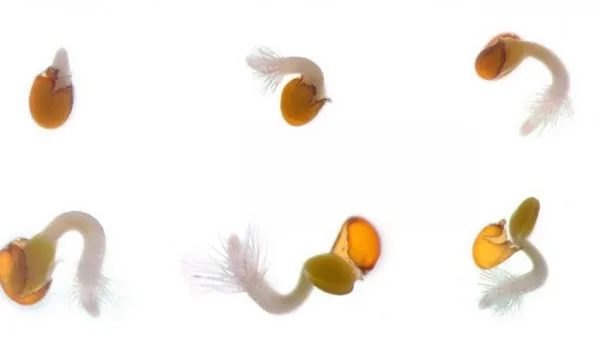Timing is everything for seeds. Lying beneath the soil, they wait for the perfect moment to emerge, taking cues from the environment above. Germinate when it’s too hot and dry, and the seeds run the risk of death. Germinate and it’s too cold, and the outcome is much the same.

The researchers exposed the seeds of Arabidopsis thaliana to 13 different chilling treatments and measured their responses. (Alena Kravchenko)
“Germinating at the right time of year is something that should be under very strong selection, and to germinate during favorable seasonal conditions, seeds need to use different environmental cues in different parts of the world with different climates,” said Distinguished Professor Johanna Schmitt, Department of Evolution and Ecology. “It not only determines whether the seedling lives or dies, but it also can affect the timing of other life-history events and cascade forward.”
In a study appearing in Proceedings of the National Academy of Sciences, Schmitt and her colleagues used the staple plant model organism Arabidopsis thaliana, known commonly as the thale cress, to uncover the genetic mechanisms that control how its seeds respond to the environment, specifically to chilly weather.
“People know a lot about dormancy in terms of release of dormancy in response to summer conditions,” said Schmitt. “But surprisingly little has been done about this other kind of cuing, responses to winter chilling.”
The researchers identified the seed dormancy gene Delay of Germination1 (DOG1) as a driver of variation in seed chilling responses in Arabidopsis thaliana.
Arabidopsis, on top of being a favorite model, is a widespread annual plant related to agricultural weed pests and crops like canola, mustard, kale, cauliflower and broccoli. The researchers also traced the genetic evolution of Arabidopsis’ flexible germination strategy, creating a gene tree that reaches back to the Ice Ages.
“Understanding the genetics behind temperature cues for germination could help us better control agricultural weeds and find better management solutions for invasive plant species that pose a threat to natural environments in the future,” said first author and postdoctoral research associate Alejandra Martínez-Berdeja.
Baby seed, it’s cold outside
Arabidopsis thaliana is a versatile species. Thriving across Eurasia and North America, it can germinate as a winter annual, a spring annual or an accelerated, abridged mixture of the two that uses a strategy called rapid cycling.
To uncover the genetic mechanisms underlying this natural variation, the team, led by Martínez-Berdeja, performed experiments on seeds from 559 Arabidopsis genotypes collected from a wide range of climates across the native Eurasian range. They then exposed the seeds to 13 different chilling treatments and measured their responses. The experiments revealed a wide range of variation in seed responses to chilling.
At one extreme, seeds with initially high germination rates entered a secondary dormancy stage when exposed to prolonged chilly temperatures. This strategy prevents spring germination after winter chilling, enforcing a winter annual life history. Many of these seeds came from Arabidopsis populations in Scandinavia and the Iberian Peninsula.
On the flipside, seeds with low germination rates at ambient temperatures kick-started germination when exposed to brief periods of chilly temperatures and didn’t re-enter dormancy after prolonged cold. These seeds behaved more like spring annual or rapid cycling Arabidopsis populations, which are often found at mid-latitudes across Eurasia and in populations introduced to North America.
Schmitt noted that these varieties are often found in agricultural spaces. “You see these weeds in plowed fields and disturbed places where they’ll germinate and flower and set seed pretty much all year-round.”
Getting into the weeds
To pinpoint the gene responsible for Arabidopsis’ various responses to chilly temperatures, the team performed a genome-wide association analysis. They found a “humongous peak” of association over the DOG1 gene. While DOG1 gene’s role in seed dormancy was known, it had never been implicated in a chilling response, according to Schmitt.
What’s more, the two camps of seeds exhibited two distinct variants of DOG1, one associated with a secondary dormancy response to cold and one associated with the lack of a secondary dormancy response to cold. The latter is characteristic of spring and rapid cycling annuals.
To trace how these variants of DOG1 arose, Michelle Stitzer, ’19 Ph.D. in Population Biology, constructed a DOG1 gene tree that went back some 500,000 years to the Pleistocene, commonly known as the Ice Ages. During that time, the Iberian Peninsula was a glacial refugium, a warm oasis that allowed flora to thrive. These ancient Arabidopsis populations possessed DOG1 genes similar to the modern-day winter-annual Scandinavian and Iberian Peninsula populations, which initiate secondary dormancy when exposed to prolonged chilly temperatures.
This may have been an advantageous survival strategy in the face of long, cold Ice Age winters.
As the Earth’s climate cycled through repeated Ice Ages interspersed with warm periods, different germination strategies may have been favored. Around 365,000 years ago, a new mutation arose in the DOG1 gene and spread across Eurasia, according to the researchers. The mutation allowed the plants to become more malleable in their life-history strategies, like the modern spring annual and rapid cycling populations. This flexible germination behavior may have allowed Arabidopsis to spread to new environments. During subsequent interglacial periods, Arabidopsis continued spreading, its pioneering populations naturally finding new niches. With the development of agricultural practices, it continued to thrive until it became a globetrotter.
“Our project uncovered a crucial role of the DOG1 gene, which allows seeds to respond to signals from the environment that indicate the optimal time for germination,” said Martínez-Berdeja.
“Understanding the genetic mechanisms for response to germination cuing, well, that’s important for understanding how weeds and wild plants evolve,” said Schmitt. “By combining ecological information, the climatic information, the phenotypic information and the genomics information, there’s this complete story that’s starting to emerge.”
Arabidopsis’ germination story is one that farmers may want to heed.
Source: UC Davis (Greg Watry)
